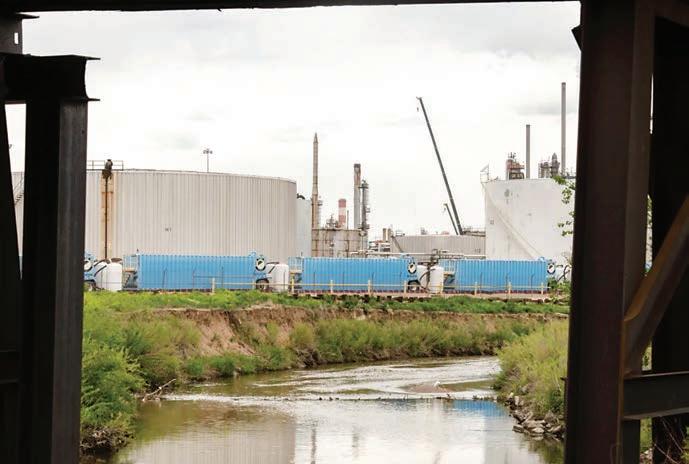
3 minute read
Suncor’s ‘forever chemicals’ pouring into metro Denver rivers spike again
BY MICHAEL BOOTH THE COLORADO SUN
Discharges of water tainted with PFAS “forever chemicals” from the Suncor re nery spiked again in May, an environmental watchdog group said, following high readings in November and January.

Suncor, which has used re ghting foam containing PFAS chemicals for years on the sprawling Commerce City property, reported May discharges into Sand Creek at 218 parts per trillion of variants of the chemicals known as PFOS, PFOA and PFNA, according to Earthjustice attorneys. e group monitors Suncor’s required reporting to state water quality regulators.
Immediately after leaving Suncor, the discharged water is carried by Sand Creek into the South Platte River as it ows through Adams County. e May discharge peaks were more than three times the PFAS limits proposed in a 2022 draft renewal permit written by state regulators to cover
Meet Whisper!
Suncor’s water discharges.
e report shows Suncor’s “continuing inability to reliably treat their PFAS to meet even the division’s proposed 70 parts per trillion limit, and that limit is still way too high and based on outdated information,” Earthjustice attorney Caitlin Miller said. “Suncor’s continued failure negatively impacts Sand Creek and the South Platte River.” e thousands of variations of PFAS chemicals are used in countless consumer and industrial products for water and stain resistance, among other functions. ey were used for decades in everything from carpet to re ghting products to clothing and fast-food packaging, though manufacturers are trying to phase them out of many products and states like Colorado are banning them. States’ attorney general ofces, including Colorado, are suing manufacturers like 3M and DuPont to recover water ltration and ground cleanup costs.
Neither Suncor nor state regulators responded to new questions about the high discharge readings from May.
PFAS chemicals do not easily break down in the environment, thus the “forever” moniker, and have been found in sh, wildlife and in the bloodstream of most humans tested.
Until March, the EPA’s drinking water guideline — not a mandate to water agencies, but health guidance — had been limiting PFAS to 70 parts per trillion. en the EPA issued sharply lower levels that are now drinking water mandates that cities must achieve, setting them as low as 0.02 parts per trillion for the variant PFOS, and 0.004 ppt for PFOA.
Earthjustice had previously agged Suncor re nery releases of PFAS. One out ow measured at Suncor found November readings at 1,100 parts per trillion of PFOS in discharges, or 55,000 times the downward-revised EPA requirements. Discharges of 54 parts per trillion of PFOA that month were 13,500 times the new EPA limits on that chemical, Earthjustice said. e high discharges remained in January, though not as elevated. e February report showed lower levels. e elevated discharges came as state clean water o cials worked to complete revisions to Suncor’s water out ow pollution permits that were rst opened to public comments nearly 18 months ago. Colorado o cials noted at the time they had included PFAS limits for the rst time in a draft of the revised permit. e re nery recently announced $100 million in repairs to reduce its air emissions. e state’s proposed draft permit revision for Suncor rst revealed in 2022 set PFAS discharge limits at the same 70 parts per trillion that had been the EPA drinking water guideline until this year. In response to the high Suncor discharges in 2022 and early 2023, and the EPA’s March 2023 revisions, state regulators said they were reconsidering the draft permit. ey have not o ered a timetable on when those revisions will be put out for another public comment period. After Earthjustice called out their November and January PFAS releases, Suncor said the company’s testing away from the re nery outow did not show any higher than normal contamination downstream on Sand Creek or in the South Platte
Suncor had major December res that prompted air pollution notices and a long shutdown of re ning operations, and environmental groups monitoring pollution there speculate the re ghting foam commonly used in industrial res could have contributed to more PFAS runo .
River nearby.
Suncor’s statement said a sampling study by an independent rm in May 2022 said “Suncor’s PFAS contributions are not impacting the South Platte River in any meaningful way.”
Earthjustice disputes that conclusion, saying a report from Westwater Hydrology at the “Outfall 20” in question “accounted for between 16-47% of total PFAS found in Sand Creek, and 3-18% of PFAS found in the South Platte River downstream of the facility.” is story is from e Colorado Sun, a journalist-owned news outlet based in Denver and covering the state. For more, and to support e Colorado Sun, visit coloradosun.com. e Colorado Sun is a partner in the Colorado News Conservancy, owner of Colorado Community Media.




